Doctored Content Spreads During Crucial Phases of Indian Election
Politicians amplified doctored photos and videos on social media amid ongoing elections
Doctored Content Spreads During Crucial Phases of Indian Election
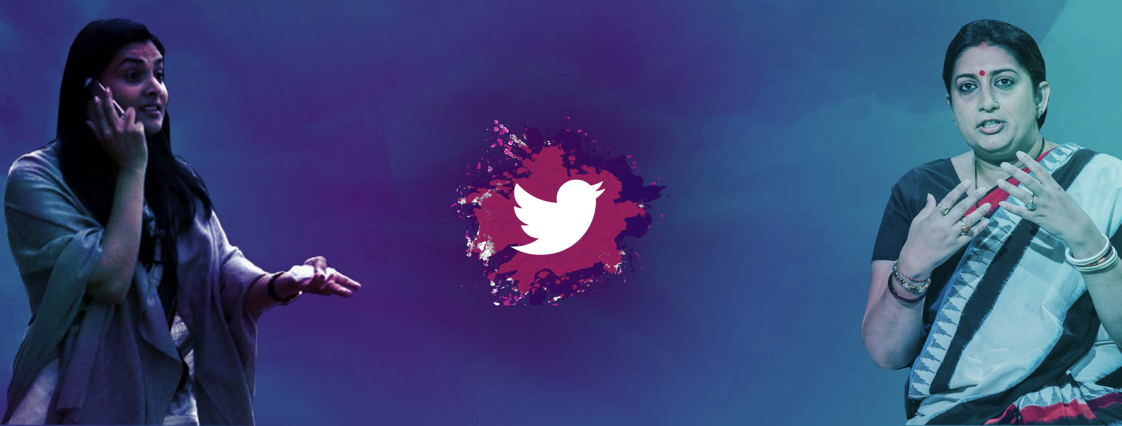
BANNER: (Source:@KaranKanishk/DFRLab via PTI, photo at left; WEF/Flickr, photo at right)
Dissemination of misinformation and disinformation in India shows no sign of abating, especially during key phases the 2019 election cycle.
As voters took to the polls in the crucial fourth and fifth phases of the election in bellwether states such as Uttar Pradesh (UP) and Maharashtra, social media platforms such as Twitter and Facebook continue to see doctored photos and videos widely shared across the platform as a means of political persuasion or attack. Many of these photos and videos have gone viral, shared and liked by tens of thousands of Indian social media users.
The timing and frequency of release of the doctored photos and videos during polling in key states, in particular, suggested that social media influencers sought to leverage their large followings on the social media platforms for political gain. The amplification of doctored content at this crucial juncture in the election appears to be for the express purpose of manipulating Indian social media users’ political opinions prior to voting.
India’s six-week long (April 11 to May 19) “festival of democracy” is divided into seven phases of voting — with each phase comprising different regions around the country — and constitutes the single largest exercise of political will on the globe. With 900 million voters participating, the ongoing election will see roughly one in eight people on Earth deciding which political party will rule over the sub-continent for the next five years. The election will determine control of the Lok Sabha, India’s house of representatives, which is responsible for nominating and confirming the prime minister.
In the lead up to and during the 2019 cycle to date, mainstream political personalities with large social media followings from many of the competing parties — including Smriti Irani, a serving cabinet minister for the ruling Bharatiya Janata Party (BJP), and Divya Spandana, director of social media and communications for the opposition Indian Congress Party (INC) — have amplified manipulated content.
The DFRLab and various fact-checking organizations have issued prior warnings on the nature and scope of the manipulated content circulating ahead of the elections, and international and domestic media outlets have devoted ample coverage to the problem. The use of doctored photos and videos on social media to manipulate public opinion, however, continues unabated. That prominent political figures on both ends of the political spectrum are amplifying the content exacerbates the problem.
Within this context, amplification of such doctored content by mainstream political figures in the build-up to polling in key battleground states, such as UP and Mahrashtra, is cause for great concern — UP and Maharashtra combined account for the most seats (128) in the Lok Sabha, the lower house in India’s bicameral parliamentary system.
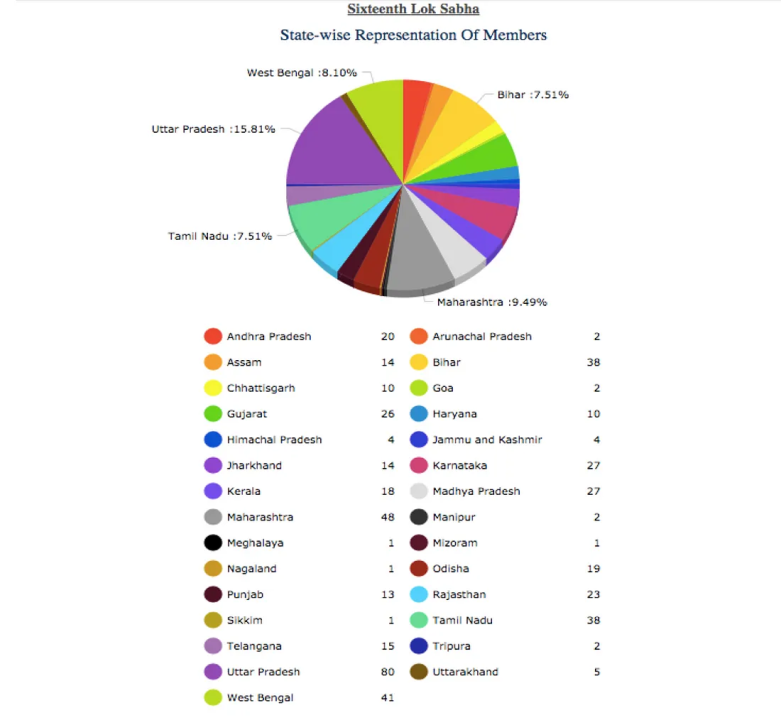
Disinformation Goes Mainstream
Manipulated media content can range in scope and scale. In the context of the Indian elections, it has ranged from a doctored photo inviting comparisons between the current Prime Minister of India, Narendra Modi, and Adolf Hitler to an edited video that purports to show INC leader for East Uttar Pradesh Priyanka Gandhi teaching children abusive political slogans while on the campaign trail.
When manipulated media content is shared by prominent political figures, its impact multiplies. It can push politically engaged users toward more extreme positions, making compromise increasingly difficult while promoting a personality-driven conception of news consumption, undermining public trust in the impartiality and objectivity of India’s traditional media sources.
Abusive Political Sloganeering
Many prominent figures in the BJP shared a strategically edited video allegedly showing INC leader Priyanka Gandhi “teaching” children abusive sloganeering during a campaign stop. In the full un-edited video, however, she can be seen telling the children to stop using the abusive language, saying “do not use this one, this [slogan] is not good.”
Current Minister of Textile Smriti Irani included the edited version of the video in a tweet and referred to Prime Minister Modi as being unjustly abused by Priyanka Gandhi, one of the most popular INC leaders. The post also claimed that the opposition leader’s only claim to fame was her “nose,” a reference to Gandhi’s resemblance to her grandmother and former-Prime Minister of India, Indira Gandhi. Irani’s verified account has 9.07 million followers.

The director of BJP’s “Women’s Wing of Social Media,” Priti Gandhi, also posted the video, seeking to implicate Priyanka Gandhi (no relation) directly by accusing her of allegedly “giggling gleefully” at the abusive slogans. The caption in white on the top of the video translates to “This is the kind of language that is taught to children by the Congress [Party].” Priti Gandhi’s verified profile, at the time of this analysis, had 371,000 followers on Twitter.
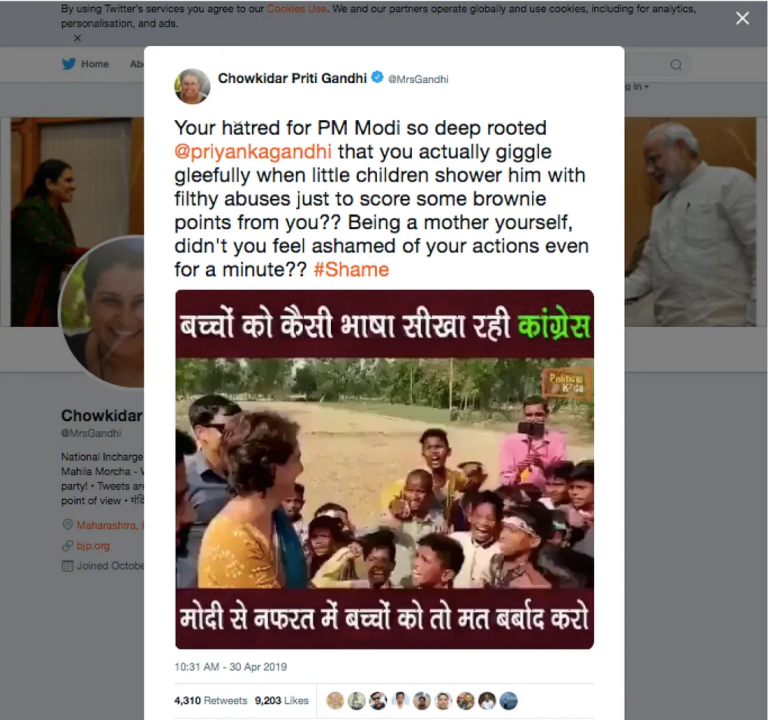
Popular Bollywood actor and high-profile BJP supporter Paresh Rawal also amplified the video, as, in response to Irani’s tweet, he claimed to be unsurprised by the alleged behavior of the opposition leader. This idea ties into broader claims made by the BJP and its allies, such as Irani and Rawal, whose tweets imply that this type of behavior indicates a personal dislike of Prime Minister Modi, a feature he asserts is a central pretext of INC’s campaign messaging. Rawal’s verified profile had 2.72 million followers at the time of analysis, making his retweets a particularly robust form of amplification.
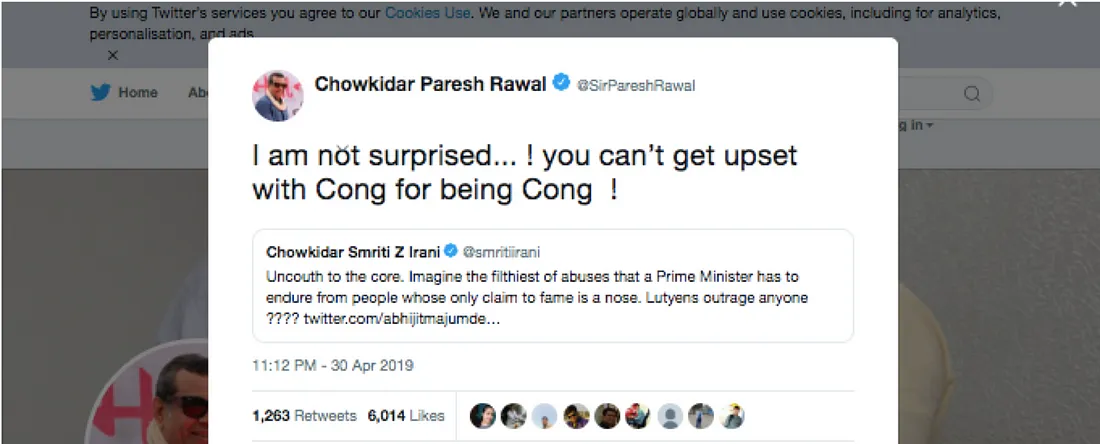
Birds of a Feather?
In a similar vein, Divya Spandana, a former member of parliament and head of the opposition party’s social media and digital communications, retweeted a photoshopped image that shows a side-by-side comparison of current Prime Minister and BJP leader Narendra Modi and Adolf Hitler. In both images, the politicians can be seen in similar poses — courtesy of the photo manipulation that took Modi’s hands from an original photo and inserted them in a mirror image onto the photo of Hitler — while playing with children.
Spandana’s tweet invoked a negative comparison between the two leaders, suggesting that they both had attempted to mask their authoritarian leadership styles by presenting a more gentle public image. The tweet did not make any direct correlation between the two photos, social media users were invited to make a comparison between the two through the use of an open-ended question “what are your thoughts?” At the time of analysis, Spandana’s verified profile had 830,000 followers on Twitter.
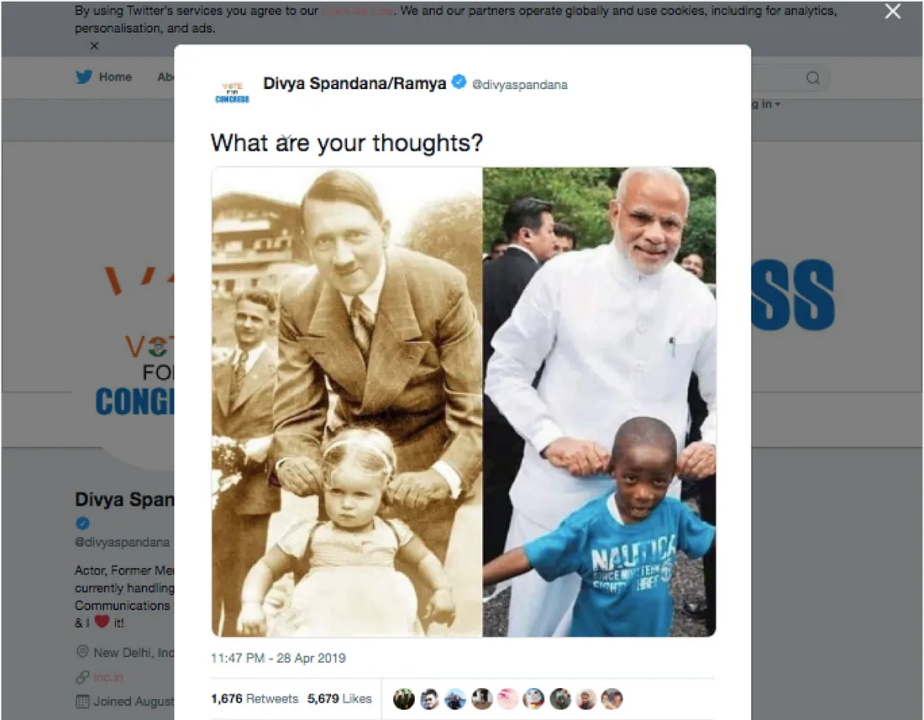
Ram Gopal Varma, a popular Bollywood director and high-profile Modi critic, subsequently reused the same visual comparison a day after the initial tweet was debunked. Gopal Varma’s verified profile had 3.5 million followers on Twitter at the time of analysis, making his account — as with Paresh Rawal — a particularly significant vector for dissemination.
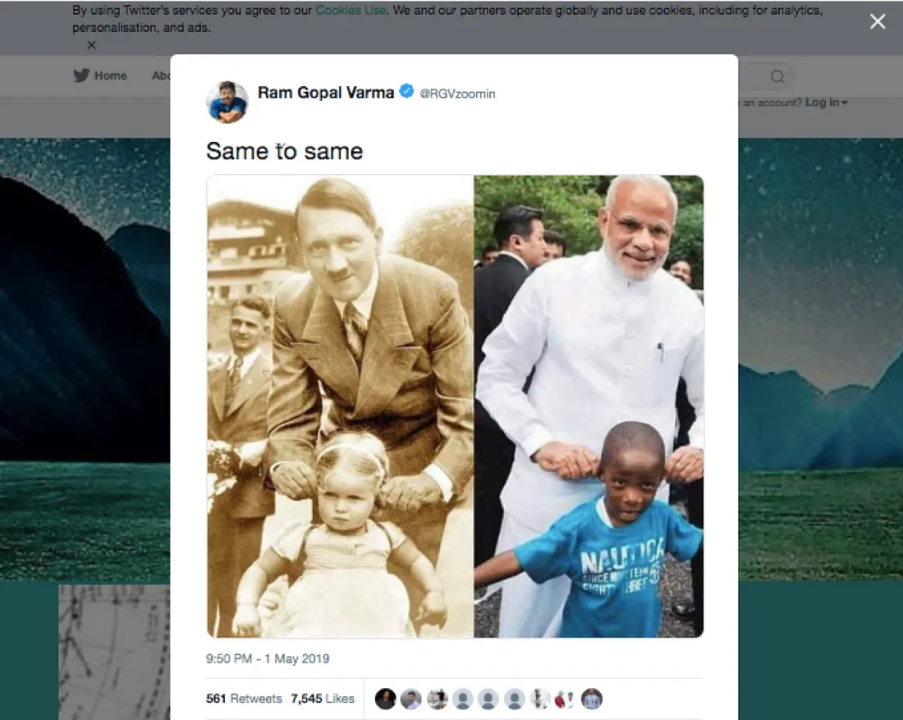
Reality Over Fiction
While political figures on both ends of the spectrum have been accused of spreading mis- and disinformation, those affiliated with the ruling party have greater online reach than those affiliated with the opposition.
Moreover, in spite of the fact that domestic fact-checking organizations such as Alt News and Boom Fact Check had swiftly identified the manipulated content as doctored, Divya Spandana did not delete her tweet until May 3, 2019, leaving it up for five days. Smriti Irani, on the other hand, had not yet deleted the highly edited video from her profile at the time of this analysis.
On May 1, 2019, AltNews co-founder Mohammed Zubair responded to the original Twitter post by Irani, inquiring as to why she was using a doctored video and providing a link to the full video. As of May 2, 2019, Zubair’s tweet had been retweeted 754 times and had garnered 2,104 likes. As is common, the factual correction received much less engagement than did the original tweet.
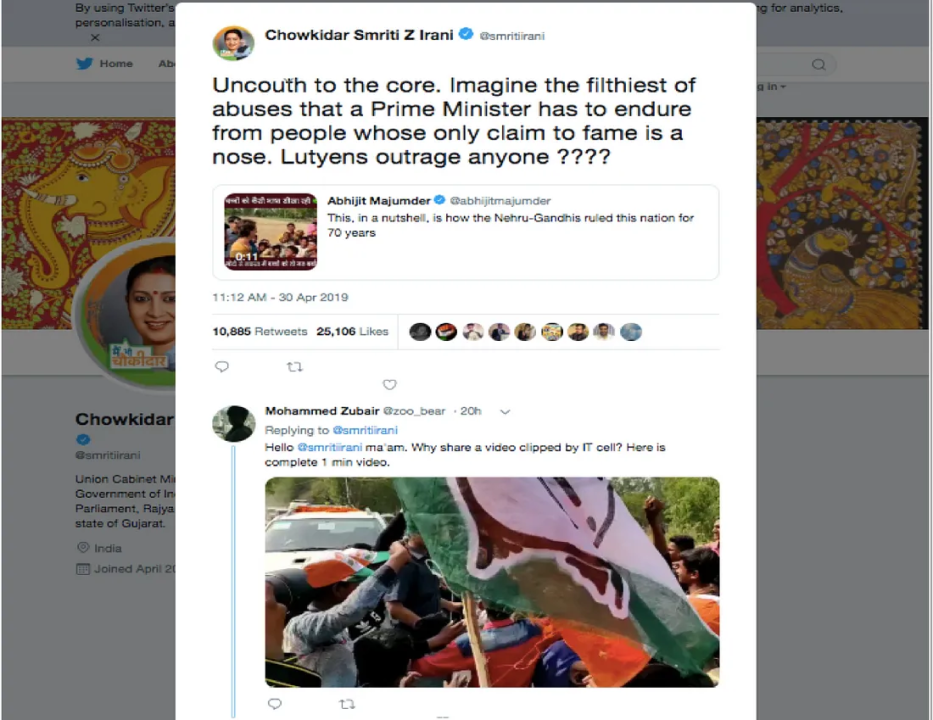
Unlike Irani, following a retweet from Pratik Sinha, another co-founder of AltNews, in which he questioned the Hitler photo’s authenticity, Spandana subsequently deleted her original tweet. Sinha’s tweet had been retweeted 496 times and had received 2,100 likes at the time of analysis; as with Zubair’s tweet challenging Irani, Sinha’s correction received much less attention than the initial tweet.
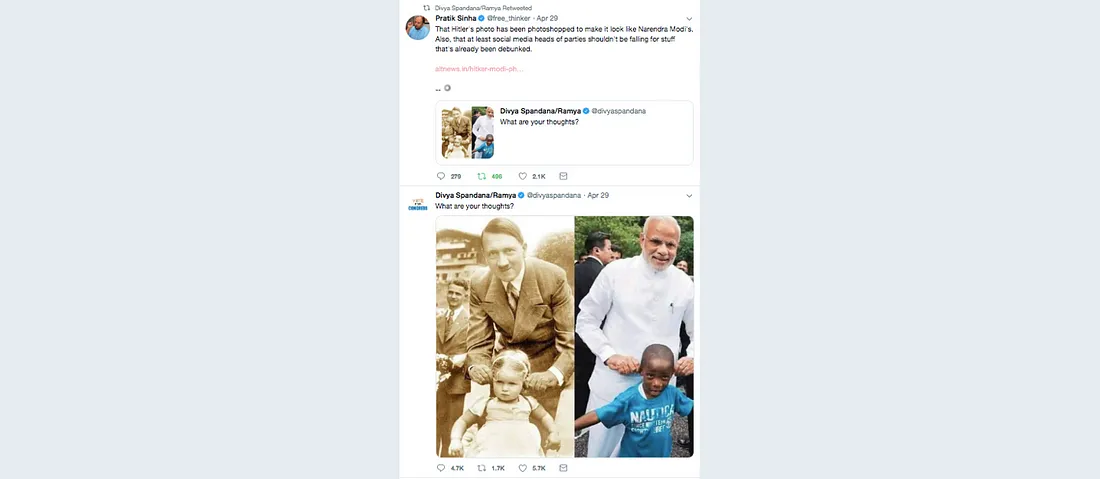
Further Instances of Misleading Claims Around Videos and Photos
Indian social media users saw a number of other misleading videos and clips being shared ahead of the fourth and fifth phases of the election. These clips included an old video that showed BJP workers being admonished by a crowd in Gujarat, purportedly demonstrating BJP’s unpopularity in the key polling state of West Bengal. Another viral post claimed pictures of bikini-clad Swiss actress Ursula Andress, taken from the James Bond movie Dr. No, to be photos of a younger Sonia Gandhi, former president of INC and mother of current INC president and candidate for prime minister Rahul Gandhi.
While pernicious in its accusation of corruption, another more humorous video showed a Gujarati man pointing to several world heritage sites located in the Piazza Castello in Turin, Italy. In the video, the Indian tourist pointed at multiple buildings in the public square and claimed that the UNESCO protected buildings have been purchased by INC president Rahul Gandhi with misappropriated funds from India.
Conclusion
According to the latest data released by the Reuters Internet Institute and YouGov, a study of India’s English-speaking citizens revealed that 52 percent utilized Facebook and WhatsApp for the latest news. Moreover, 63 percent of respondents to the survey revealed that the headline or picture of the news item was the most important factor when deciding on the veracity of the source, while for 56 percent, the identity of the person sharing the information proved to be the deciding factor.
This findings of the Reuters survey are further reinforced by data from Microsoft’s third Digital Civility Index (DCI), released to commemorate Safe Internet Day on February 5. According to the DCI, 64 percent of Indians had reported encountering mis- and disinformation online, a figure 7 percentage points higher than the global average of 57 percent.
Overall, these findings suggest a digital environment that is vulnerable to mis- and disinformation, in part due to Indian social media users’ reliance on social media platforms for news consumption. Furthermore, the tendency of Indian social media users to trust information based solely on headlines, photos, and the identity of the individual sharing the information also highlights their susceptibility to and overreliance on cognitive heuristics, or mental shortcuts, in their news consumption habits.
Register for the DFRLab’s upcoming 360/OS summit, to be held in London on June 20–21. Join us for two days of interactive sessions and join a growing network of #DigitalSherlocks fighting for facts worldwide!

